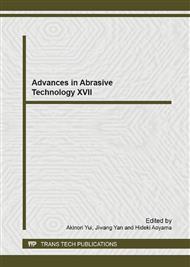p.340
p.344
p.350
p.355
p.361
p.367
p.373
p.377
p.383
Investigation Performance of AlCrN_Based Coated Broaching Tool in Broaching of Gas Turbine Material X12CrMoWVNbN1011
Abstract:
Pull broaching fir-tree slots of gas turbine is one of the most productive precision machining processes when machining simple surfaces or complex contours. Tool edge chipping and wear of uncoated broaching tool become a serious problem in the currently broaching of gas turbine discs. Therefore, tool coating can be used to improve the wear resistance of broaching tool. AlCrN-based coatings have been developed as a high hardness coating for cutters due to excellent resistance to oxidation which is higher than that of conventional coatings. However, few researches had paid attention to investigating AlCrN-based coating tool performance in the broaching process, especially in machining of heat-resisting material of heavy-duty gas turbine discs. In this paper, experiments of broaching heat-resisting material X12CrMoWVNbN1011 were investigated. In order to obtain suitable and ideal broaching tool, the AlCrN coated or uncoated T15 broaching tools were also compared. Cutting force, cutting temperature, and tool wear were measured in the broaching experiments. Results showed that: (1) with a little changed cutting load and tool edge radius, AlCrN-based coating was found to have more significantly influence in improving the tool life as comparing to uncoated tool. The similar wear forms was observed by comparing coated tool and uncoated tool. The conclusions of the study can help to improve heavy-duty gas turbine disc broaching process and broaching tool. (2) Owing to AlCrN coating’s unique combination of heat resistance and hardness, broaching tool could reach higher cutting performance levels. AlCrN coated tool compared with uncoated tool have much better performance in term of cutting strains or cutting temperature.
Info:
Periodical:
Pages:
361-366
Citation:
Online since:
September 2014
Authors:
Keywords:
Price:
Сopyright:
© 2014 Trans Tech Publications Ltd. All Rights Reserved
Share:
Citation:


